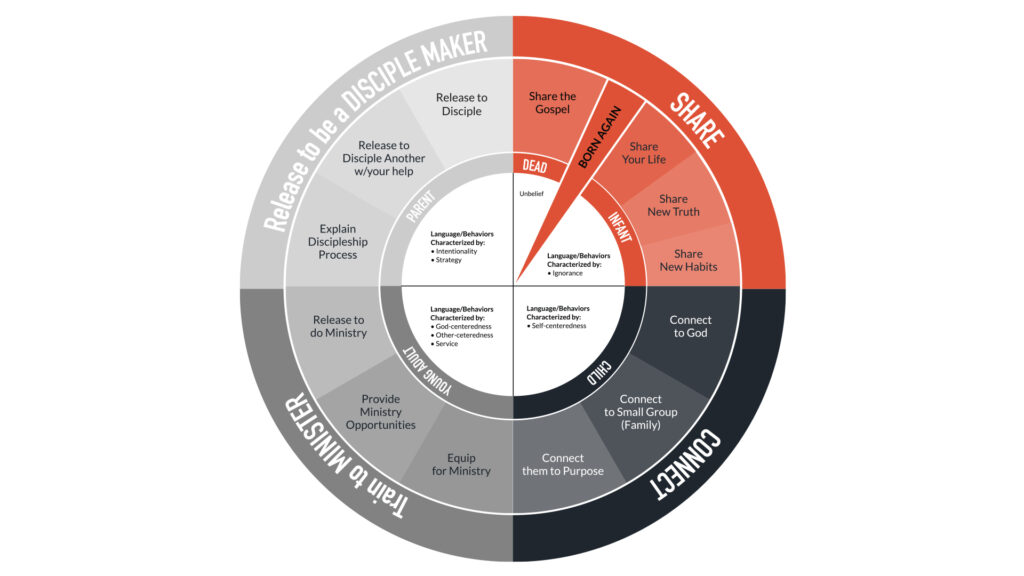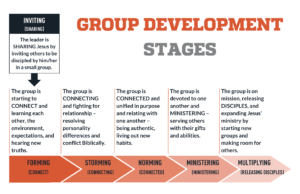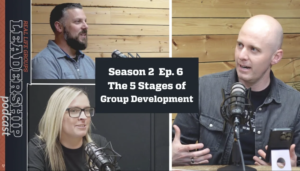It is not surprising that first-time leaders will often experience feelings of nervousness and fear when stepping up to lead a group. Even when you feel like you have some tools to navigate this new role, understanding the next steps for your group can be challenging and feel like a journey into the unknown.
In an effort to better equip leaders, our groups team at Real Life Ministries has gathered insights from multiple generations and diverse groups that we have worked with. We hope to provide new leaders (and even seasoned ones!) with a forecast of the stages you may encounter on your leadership journey and help you or your leaders feel better equipped. Although these stages will ultimately be unique within each group experience, having a general awareness of what lies ahead can be immensely helpful.
Our main goal is to equip group leaders to identify which stage their group is currently in and how they can facilitate progress and development. This understanding will enable them to guide their group effectively towards their desired outcome.
Our main goal is to equip group leaders to identify which stage their group is currently in and how they can facilitate progress and development. This understanding helps them guide their group effectively. Share on XNow let’s dive into an overview of these stages. Bruce Tuckerman was an American psychological researcher who published a theory in the 1960’s regarding group dynamics and development. In a nutshell, his theory states that a team or a group will experience certain stages with one another, and that those stages are needed in order to be a successful team that is on mission toward the goal you’re trying to achieve.
Businesses continue to use Tuckerman’s model, and there are some Churches that have adopted the model and integrated it into their own trainings for small groups. The 4 phrases he used for the group development stages are Forming, Storming, Norming and Performing. As a church, we are borrowing from his language and definitions while aligning them in a Biblical way for our purposes. We believe that when it comes to Small Groups or Life Groups, the terms ministering and multiplying line up better Biblically for our group stages. So for our application, we consider the 5 stages of a group to be Forming, Storming, Norming, Ministering and Multiplying.
When considering how these concepts align with our core values here at Real Life Ministries – we will look at them in relation to our share and connect stages on the discipleship wheel. Beginning with the forming stage – This is the forming stage, you are starting from scratch, building a connection with each other as strangers. This is where group members connect and build trust with one another, and as you share your life and express your faith, you begin to invite members into a personal relationship with you.
As the group moves into the ministering phase, we find it similar to a young adult stage, where individuals are actively engaged in serving both within and outside of the group. Finally, multiplication occurs when someone within the group becomes a disciple maker themselves and begins their own group. In essence, this aligns with our discipleship wheel framework and stages of spiritual growth.

In order to assess the progress of a group beyond its initial season, it is important for the group leader to understand where the group currently stands. This can be done by actively listening to what is being shared within the group or even during casual conversations outside of the group setting, such as over coffee or a meal. By paying attention to these interactions, the leader can gain insights into the dynamics and sentiments of their members.
During the forming stage, members usually exhibit polite and calm behavior. As the group progresses into the storming phase, it is not uncommon for conflicts to arise. This should not be seen as a negative development; rather, it presents an opportunity for leaders to model how to handle biblical conflict in a constructive manner. In order to have effective group dynamics, it is important for leaders to be willing to engage in conflict and model forgiveness and understanding. Scriptures often discuss the concept of overlooking certain behaviors. Leaders should strive to be curious about the members of their group and understand where they are coming from. By modeling Christ-like behavior, leaders can show others the path that Jesus has set for us in our lives. In this stage especially, people may begin opening up and sharing more about their thoughts and emotions.
Lastly, when a group reaches the norming stage, there tends to be a sense of cohesion and established norms. It becomes easier for individuals to contribute openly and comfortably within this environment. It’s important for leaders to foster an atmosphere where everyone feels valued and encouraged to participate.
By observing these different stages of group development – forming, storming, norming – leaders can gain valuable insights into their members’ progress. This understanding enables them to provide appropriate guidance and support as their groups continue on their journey together.
It is essential to establish a sense of rhythm and cohesion within your group. Transparency and open communication are key aspects that contribute to a comfortable environment. However, it is also crucial to assess the progress of each individual throughout different seasons. It is not uncommon for some members to perceive themselves as more advanced than they actually are. Therefore, active listening and careful observation are important tools in understanding their values and actions. Weekly church attendance, tithing, and serving others can serve as valuable indicators of an individual’s spiritual growth.
Let’s discuss the danger of remaining in one of these stages for a moment. The ministering stage can be the most tempting to remain in as it creates a strong bond with your closest allies. Who wants to separate from their best friends, after all? It’s understandable that as a leader, you may feel inclined to stay in this stage for an extended period, allowing your team members to do the same. However, it’s essential to consider what comes next spiritually – creating space for further disciple-making. This requires constantly casting a vision that emphasizes we won’t always be together physically, but our relationships will endure. Perhaps even stronger is the shoulder-to-shoulder connection that develops when we take on leadership roles together. This kind of relationship allows us to understand and support one another better during challenging times. The danger lies in forming more of a social club where everyone remains stuck together without progressing spiritually. We can observe examples of this dynamic in the Bible, particularly with Jesus inviting his disciples into an intimate relationship and forming them into a cohesive group from the very beginning.
It is important to leverage the different seasons within your group in order to foster growth. Growth does not happen just during scheduled group meetings, but during the course all the time spent together. As a group leader, it is crucial to genuinely care for your group members and be aware of the spiritual battle they may be facing. Additionally, as a leader, it is important to anticipate the different seasons and prepare your group accordingly. Whether it’s preparing for storming in a new group or reminding an established group to stay focused on the vision, looking ahead and caring for your people are essential roles of a leader.
This article was taken in part from Season 2 Episode 6 of the Real Life Groups Leadership podcast linked below:
Real Life Groups Leadership Podcast: The 5 Stages of Group Development
You will find more Discipleship resources at Realliferesources.org
You can find more information on the Real Life Discipleship Wheel and Spiritual Growth Chart in our Real Life Training Manual linked below:









